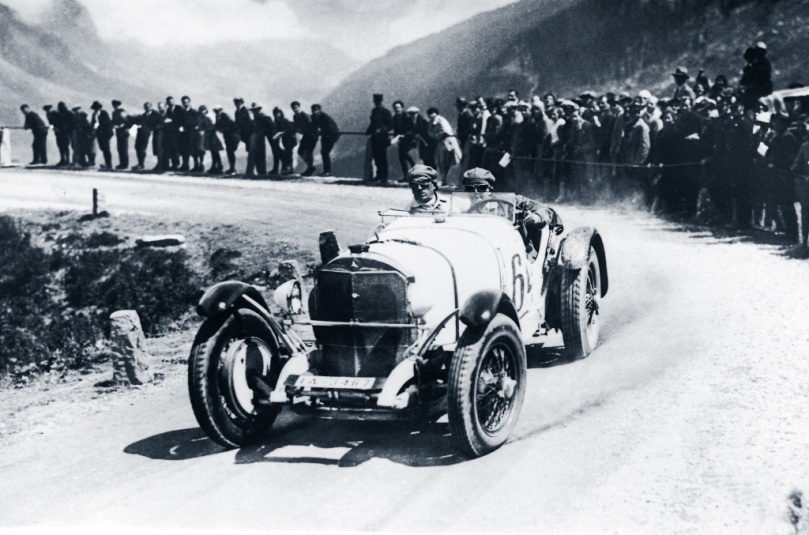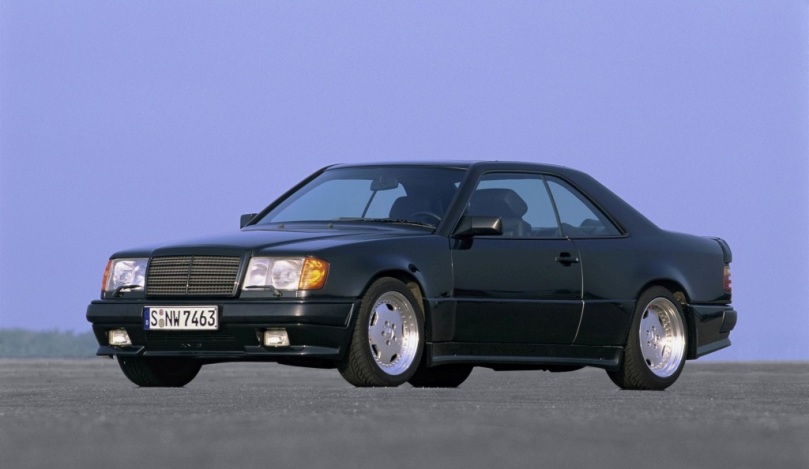
International Klausenpass Race in Switzerland, 9 to 10 August 1930. Rudolf Caracciola (starting number 64) with a Mercedes-Benz model SSK. Caracciola won in the sports car class up to 8-litre displacement and achieved the race´s sports car record.
Stuttgart. Mercedes-Benz SSK models on the Silvretta high alpine road: the meeting of two masterpieces of the engineering artistry of their day at the 20th Silvretta Classic Rally Montafon.
The Mercedes-Benz SSK built in 1928 represents the family of Kompressor sports cars S, SS and SSK. At the end of the 1920s and beginning of the 1930s they enjoyed considerable success in races and as exclusive sporty private vehicles. The victorious cars were nicknamed the “White Elephants” by their fans. For these powerpacks painted in Germany´s racing colour of white are strong, powerful – and the awesome roaring of their belt-driven supercharger, which manually compresses the charge air is reminiscent of the pachyderm´s trumpeting.
The model designation of the SSK from model series W 06 stands for “Super-Sport-Kurz” (“super sport short”). With its manually charged 7.1-litre six-cylinder inline engine the car has an output of 125 kW (170 hp), and with its belt-driven supercharger switched on 165 kW (225 hp).
The top speed is 192 km/h. This high-performance sports car is – like the other models in its family – among the most successful racing cars of its era: at the premiere of the model S Rudolf Caracciola won the inaugural race on the Nürburgring on 19 June 1927. This was following by numerous further victories, including those in high-calibre mountain races such as the International Klausenpass Race in Switzerland.
In the summer of 1928, works driver Caracciola won the Gabelbach Race at the first attempt as well as the races at Schauinsland and Mont Ventoux with the brand-new Mercedes-Benz SSK. In 1930 Caracciola became European Mountain Champion and achieved a class victory in the long-distance Mille Miglia race in Italy in the SSK. Then in 1931 in the Mercedes-Benz SSKL – the final level of development of the SSK – he was the first non-Italian racing driver to win the overall ranking in the “Thousand Miles”.
It was in the grand era of the “White Elephants” that work also began on what later became the Silvretta high alpine road. Its first section from Partenen to the Vermunt reservoir was built from 1925 by Illwerke for transporting materials to reservoir and power station construction sites. The high alpine road was then opened in 1954, with the course it still takes today. It is traditionally part of the route in the renowned Silvretta Classic Rally Montafon regularity race for classic cars and young classics alike.
Coveted coupé classics
The future has a tradition at Mercedes-Benz: at the Silvretta Classic Rally Montafon four coupés in the upper-medium-size category also illustrate the fact that contemporary sporty elegance is at the core of the brand history. The exclusive two-door cars come from the model series W 114 (“Stroke 8”) and C 124. These model series are also among the especially coveted young classics and classic cars from ALL TIME STARS, the Mercedes-Benz Classic vehicle outlet.
The coupés are being piloted by drivers such as the Mercedes-Benz Brand Ambassadors and racing drivers Klaus Ludwig and Karl Wendlinger. Born in 1968 in Kufstein (Austria), Karl Wendlinger began his motorsport career as a teenager in karting and changed over to Formula racing in the 1980s. In 1989 he became German Formula 3 Champion, and from 1991 he drove in Formula 1 – from 1994 onwards for the Sauber-Mercedes team.
This was followed by drives in the DTM, Formula 3000 and in long-distance races. Since 2012, Karl Wendlinger has been a Mercedes-AMG brand ambassador and instructor at the AMG Driving Academy. Klaus Ludwig, feted by his fans as “King Ludwig”, was born in 1949 in Bonn. The three-times Le Mans winner, two-times German Racing Champion and DTM Champion of 1988 moved to the DTM team AMG-Mercedes in 1989.
He won two Championship titles for Mercedes-Benz (1992 and 1994, Vice Championship in 1991) with a total of 19 race wins. In 2000 he ended his racing career with 3rd place in the overall DTM ranking in the Mercedes-Benz CLK DTM.

Stylish sportiness
The Mercedes-Benz coupé history stretches right back to the beginnings of the brand´s history. Whilst the Benz Coupé from 1895 and the Daimler Coupé of 1897 bore a clear family resemblance to the fine horse carriages of the same name, at around the turn of the century the automotive coupé established itself as an autonomous body shape. Above all since the 1930s ever more discerning drivers opted for closed coupés with an exclusive body and two or four seats.
It was at this time that the current definition of a coupé as a closed touring car with two doors plus a flowing side line came about. There was also the omission of the B-pillar, plus frameless side windows. The combination of these values of the stylish, sporty touring car with a high utility value for leisure and work have since made the coupé one of the most successful body variants in numerous Mercedes-Benz model series.
In autumn 2003 the Stuttgart brand successfully extended the term coupé: at the International Motor Show in Frankfurt/Main it unveiled the four-door “Vision CLS” study. The production vehicle followed in 2004. Since 2013 there has also been the CLA in the compact class. (Fuel consumption combined: 7.3-3.7 l/100 km, CO2 emissions combined: 171-98 g/km*).
The tradition of coupés in the Mercedes-Benz medium-size category started in the winter of 1968, when the two-door variant of the “Stroke 8” model series W 114 was presented. A Mercedes-Benz 250 CE from 1969 is entering the Silvretta Classic. From 1968 this became the top model in the entire model series. For the 110 kW(150 hp) 2.5-litre six-cylinder engine with intake manifold injection was initially reserved for the coupé.
The electronically controlled fuel injection system Bosch “D-Jetronic” was used – for the first time in a Mercedes-Benz series-production passenger car. The most powerful saloon was the corresponding carburettor version with an output of 96 kW (130 hp).
The second W 114 from the company´s collection to participate in the Silvretta Classic is a 280 C from 1972. It was unveiled in that year and was fitted with a newly designed six-cylinder engine with two overhead camshafts.
The Mercedes-Benz E 320 Coupé from 1995 was part of the first generation of E-Class Coupés from Mercedes-Benz. For the C 124 model series in the upper-medium-size category presented in 1987 was – analogous to the saloons and estates – given the designation E-Class from June 1993.
This marked a change in the model designations, from then on the E at the beginning stood for the model series family, followed by a combination of three figures derived from the displacement. From 1993 there was an even more powerful variant than the E 320 Coupé (162 kW/220 hp): the top engine model E 36 AMG (200 kW/272 hp). It was the first coupé in the upper-medium-size category jointly developed by Mercedes-Benz and AMG.
What is today´s Mercedes-Benz sports car and performance brand was founded 50 years ago as an engineering office. The focus is on performance optimisation of Mercedes-Benz cars for motorsport and discerning private customers. The model series 124 formed the basis for a particularly successful model for AMG even before direct cooperation with the manufacturer: from 1986 various AMG models were created on the basis of the Mercedes-Benz 300 E in all three body shapes and they were driven by V8 engines with a displacement of 6.0 litres. The North American specialist press referred to this performance car as “The Hammer”. A 283 kW (385 hp) Mercedes-Benz 300 CE 6.0 AMG from 1988 is entering the Silvretta Classic 2017.
20 years of the Silvretta Classic
The Silvretta Classic Rally Montafon has been held since 1997 and has become established as a particularly attractive date in the automotive classic calendar. This year around 200 historically significant cars built from the 1920s to the 1990s are taking part.
The rally begins on Wednesday (5 July 2017) at 8 p.m. with the prologue for selected participants in Schruns. On the Thursday (6 July 2017) the peleton starts at 12.01 p.m. in Partenen for the first stage covering 116 kilometres. It will take the participants over the Silvretta high alpine road and the Bielerhöhe to Gargellen and Bartholomäberg to the finish in Schruns. On the two subsequent days the start is also in Partenen, but the finish will then be in Gaschurn.
On the Friday (7 July 2017) the second stage begins from 7.31 a.m. and runs over the Hahntennjoch, Piller Höhe, Flexen Pass and Bielerhöhe. At 326 kilometres it is the longest stage of the Silvretta Classic. On the Saturday (8 July 2017) the cars set out from 9.31 a.m. for the third stage, encompassing 153 kilometres. This route takes in highlights such as the Furkajoch and the Faschinajoch. The 20th Silvretta Classic Rally Montafon comes to a close with a party on the Sunday morning (9th July 2017) in St. Gallenkirch.



































